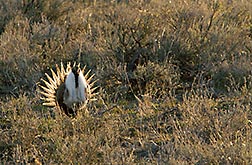| Read the magazine story to find out more. |
|
|
|
|
A Better Understanding of Rangeland Health
By Dennis O'Brien
December 30, 2015
Rangelands are grazed by livestock, serve as habitat and food for wildlife and pollinators, and filter runoff to help keep waterways clean. However, invasive weeds, wildfires, droughts, mining, and other disturbances are degrading these important resources.
U.S. Department of Agriculture (USDA) researchers are playing key roles in developing a better understanding of rangeland ecology and finding effective ways to restore them.
Matthew J. Rinella, an Agricultural Research Service (ARS) rangeland management specialist in Miles City, Montana, and his colleagues reviewed restoration reports filed by mining companies on 169 former coal mining fields subjected to various restoration efforts between 1992 and 2009. They also quantified shrubs, which are a critical source of livestock forage and provide habitat for mule deer, pronghorn, elk, and the threatened greater sage-grouse.
The results, published in Ecological Applications (June 2015), showed that when grasses were sown at high rates, shrubs were rapidly choked out before they could become established. Sowing grasses at low rates allowed shrubs to persist and reach deep into soil layers, where they could access water and nutrients inaccessible to shallow-rooted grasses. The results also showed that grasses developed well in the long run whether their seeds, which can be expensive, were sown at high or low rates. The results could be useful to mining companies, oil and gas companies, and government agencies working to improve degraded rangelands.
Meanwhile, Philip A. Fay, an ARS research ecologist in Temple, Texas, and his colleagues applied nitrogen, phosphorus, and potassium mixed with micronutrients to 42 sites in 8 countries on 5 continents. The sites, part of an established international "Nutrient Network" of rangelands, each received the same proportions of the nutrients at the start of each growing season. Researchers harvested the grass each year, calculated the amount of biomass produced, and after 5 years analyzed how the nutrients affected the productivity of native and cultivated grasses and forbs.
Researchers found that when nutrients were in short supply, productivity was limited at most of the sites. Adding multiple nutrients increased productivity by as much as 65 percent. Fay and his colleagues were also surprised to find that phosphorus and potassium were major factors in productivity on all five continents. The results, published in Nature Plants (July 2015), could lead to a better understanding of rangeland health and the potential effects of future changes.
ARS is USDA's principal intramural scientific research agency.
Read more about this research in the December 2015 issue of AgResearch.

